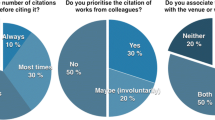Abstract
In his article “networks of Scientific Papers”,Price argued that the N-rays reference network exhibits characteristics one would expect for a cumulative and rapidly developing research area. Although subsequent researchers have questioned Price's characterization of the N-rays network, there have been no replications of Price's work for either the N-rays literature or for any other literature. We reexamine the N-rays reference network, this time distinguishing negative citations and self citations from other citations. Although previous studies of negative and self citations show they are relatively infrequent in scientific literatures, we find that both are very prominent in the N-rays literature. In addition, we show that self citations comprise most of the “recency effect” observed in the N-rays reference network, and that the high level of self citations in the N-rays literature results primarily from the character of the journal that published the majority of the N-rays papers. Our findings therefore support those who have been skeptical about Price's claim that the N-rays reference graph exemplifies basic characteristics of the structure of scientific literatures.
Similar content being viewed by others
Notes and references
D. J. de Solla Price, Networks of scientific papers,Science, 149 (1965) 510–515.
S. E. Cozzens, Using the archive: Derek Price's theory of differences among the sciences,Scientometrics, 7 (1985) 431–441.
B. C. Griffith, Derek Price's puzzles: Numerical metaphors for the operation of science,Science, Technology and Human Values, 13 (1988) 351–360.
Evidence of the continuing influence of this graph is its inclusion as the frontispiece of Borgman's recent handbook. SeeC. L. Borgman (Ed.),Scholarly Communication and Bibliometrics, Newbury Park, CA, Sage, 1990.
We have recently learned that DonalddeB. Beaver, then a graduate student working withPrice, deserves credit for the idea of arranging the N-rays papers chronologically and displaying the network structure of their references graphically. Upon seeing Beaver's graph,Price postulated that the concentration of references close to the diagonal of the graph represented the N-ray research front. In this paper we attribute the N-rays analysis toPrice because he authored the papers presenting its results and discussing its implications.
J. B. Conant,Science and Common Sense, New Haven, CT, Yale Univ. Press, 1951.
K. W. Deutsch, Scientific and humanistic knowledge in the growth of civilization, In:H. Brown (Ed.),Science and the Creative Spirit, Toronto, Univ. of Toronto Press, 1958.
Price, p. 515.
D. J. de Solla Price, Citation measures of hard science, soft science, technology and non-science, In:C. E. Nelson, D. K. Pollock (Eds),Communication among Scientists and Engineers, Lexington, MA, D.C. Heath, 1970.
, p. 15.
D. J. de Solla Price,Science Since Babylon, New Haven, CT, Yale Univ. Press, 1961.
, p. 90.
R. T. Lagemann, New light on old rays: N rays,American Journal of Physics, 45 (1977) 281–284.
M. J. Nye, N-rays: An episode in the history and psychology of science,Historical Studies in the Physical Sciences, 11 (1980) 125–156.
Cozzens,.
In.Price distinguished between “references” and “citations” by specifying that when paperA cites paperB, the bibliographic connection between the papers is a reference for paperA but a citation for paperB. This distinction is difficult to observe strictly when discussing reference network graphs because the dots in such graphs are simultaneously references and citations.
G. F. Stradling, A resume of the literature of the N-rays, the physiological rays and the heavy emission,Franklin Institute Journal, 164 (1907) 57–74, 113–30, 177–199.
Except for six books included among the 22 summaries, the 84 items were usually only a few lines in length and contained no bibliographic references.
We have just learned from DonalddeB. Beaver that our supposition is correct;Price used Stradling's bibliography as his source list for N-rays documents.
For substantially different interpretations of Wood's role in bringing about the end of research on N-rays, seeNye, andM. Ashmore, The theatre of the blind: Starring a promethean prankster, a phoney phenomenon, a prism, a pocket, and a piece of wood,Social Studies of Science, 23 (1993), 67–106. Surprisingly, the historian (Nye) emphasizes the role of Wood's paper within the context of the physics community's reception of the N-rays supporter's claims, while the sociologist (Ashmore) emphasizes Wood's rhetorical strategies in constructing an account of his visit to Blondlot's laboratory.
We followed the general guidelines given byMoravcsik andMurugesan for determining whether references were negative. SeeM. J. Moravcsik, P. Murugesan, Some results on the function and quality of citations,Social Studies of Science, 5 (1975) 86–92. We found little trouble in distinguishing the negative references in the N-rays papers, primarily because such references typically were, in Chubin and Moitra's classification, “total negational” references. SeeD. E. Chubin, S. D. Moitra, Content analysis of references: Adjunct or alternative to citation counting?Social Studies of Science, 5 (1975) 423–441.
It is difficult to count the dots in Price's N-rays graph because they sometimes overlap due to their large size relative to the fine gridPrice used (see Fig. 1). We estimate that Price's N-rays graph contains approximately 390 references, about half of which are contained in the four vertical lines of dotsPrice identified as review papers.
If the 118th or 119th paper in Price's graph is Salvioni's non-review paper, then it should be included in an assessment of the discrepancy between the number of non-review references we found and the numberPrice found. If so, the number of non-review references in Price's graph equals 226 (195 plus the 31 references in Salvioni's paper) and the discrepancy between the total numbers of references in non review papers in our graph and Price's equals 80 (225 minus 145).
C. Bazerman, Theoretical integration in experimental reports in twentieth-century physics: Spectroscopic articles in Physical Review, 1893–1980,Social Studies of Science, 14 (1984) 163–196;Price,.
G. M. Carter,Peer Review, Citations, and Biomedical Research Policy, Santa Monica, CA, Rand Corporation, 1974.
Chubin, Moitra,.
Ibid. Carter,,Moravcsik, Murugesan,.
Chubin, Moitra,, p. 427–429.
.
Author information
Authors and Affiliations
Rights and permissions
About this article
Cite this article
Baldi, S., Hargens, L.L. Reassessing the N-rays reference network: The role of self citations and negative citations. Scientometrics 34, 239–253 (1995). https://doi.org/10.1007/BF02020422
Received:
Issue Date:
DOI: https://doi.org/10.1007/BF02020422




